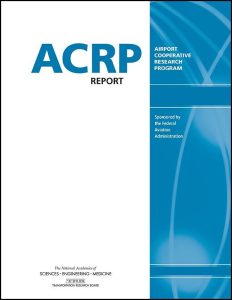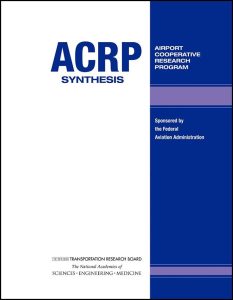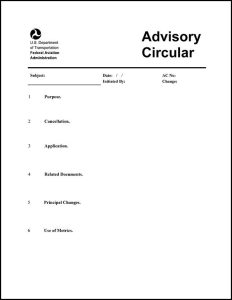To narrow the library of airside resources, use the filter boxes or airport map below or search box above.
Click an item below to expand.
Resources Matching Your Search
2013
ACRP Report 99 provides a step-by-step process for identifying, selecting, and implementing technologies to treat stormwater that has been affected by applied deicing materials. The report addresses the processes for identifying the various drivers for deicer treatment and for evaluating the appropriateness of various treatment technologies to meet an airport's specific needs. The report also provides recommendations for the design, operation, and maintenance of each treatment technology.
2020
ACRP Research Report 14, second edition, explores a wide array of practices designed to provide for the practical, cost-effective control of runoff from aircraft and airfield deicing and anti-icing operations. This second edition has been updated to reflect the latest industry practices. The report will be of particular interest to airport industry practitioners, including airport and aircraft operators, consultants, and regulators.
2017
ACRP Research Report 174 defines and discusses green stormwater infrastructure (GSI) management strategies, a relatively new approach to regulation compliance. As more airports are proactively incorporating sustainable practices in all aspects of their operations, federal and state regulatory agencies are promoting GSI strategies to comply with water regulations and requirements. Volume 1 is written for airport managers, planners, and engineers seeking to understand stormwater management and GSI compliance with regulatory standards and requirements, along with other benefits.
2017
ACRP Research Report 174 defines and discusses green stormwater infrastructure (GSI) management strategies, a relatively new approach to regulation compliance. As more airports are proactively incorporating sustainable practices in all aspects of their operations, federal and state regulatory agencies are promoting GSI strategies to comply with water regulations and requirements. Volume 2 assists airport staff with evaluating the applicability of a GSI strategy and selecting an appropriate GSI strategy.
2013
ACRP Report 86 explores a protocol for evaluating and optimizing aircraft departure procedures in terms of noise exposure, emissions, and fuel burn. An accompanying CD-ROM contains a spreadsheet-based Departure Optimization Investigation Tool (DOIT) that allows users to understand and test tradeoffs among various impact measures, including noise levels, rate of fuel consumption, and emissions.
2020
ACRP Research Report 219 identifies potential advanced ground vehicle technologies for application on the airside. Ten applications were evaluated for airside operations using a number of criteria. This report will assist airport staff or other airport stakeholders beginning to prepare for the integration of these technologies.
2016
ACRP Synthesis 69 explores drivers and outcomes of green initiatives undertaken at small commercial and general aviation airports. Drivers could include financial viability, staffing considerations, or other social or environmental factors.
2016
ACRP Synthesis 77 compiles information about airport sustainability practices and adds them to the Sustainable Aviation Guidance Alliance (SAGA) website. The SAGA website was developed to help airport operators develop sustainability programs and provide guidelines to those who have new data to input. The website contains entries on more than 900 sustainability practices that were developed by SAGA's initial stakeholder group.
2018
ACRP Synthesis 93 compiles information and examples that successfully demonstrate the value of building sustainability concepts into capacity-enhancing projects. The report describes additional resources and tools that provide information on how to select, apply, and communicate sustainability measures. The report explores how sustainability efforts often build on themselves, how lessons learned from one initiative are carried through to the next, and how this progressive learning process can enhance sustainability's role in capacity-enhancing projects over time.
2019
This advisory circular (AC) provides information on community/public involvement in airport planning. This AC is intended to advise airport sponsors, planners, and the public on the benefits of early public participation in airport planning, and the methods by which this participation may be achieved.
2015
This advisory circular (AC) provides guidance for the preparation of master plans for airports that range in size and function, from small general aviation to large commercial service facilities. The intent of this AC is to foster a flexible approach to master planning that directs attention and resources to critical issues. The scope of each master plan must be tailored to the individual airport under evaluation.
2019
ACRP Report 16, second edition, is designed to help airport practitioners, owners, operators, managers, and policymakers of small airports, who may have varying degrees of experience and backgrounds, to fulfill their responsibilities in such areas as financial management, oversight of contracts and leases, safety and security, noise impacts, community relations, compliance with federal and state obligations, facility maintenance, and capital improvements. The first edition has been edited and reformatted for currency, relevance, and usability and updated with additional information and new subject areas (e.g., unmanned aircraft systems, geographic information systems, digital notices to airmen, social media, and federal and state obligations). Also, hyperlinks to many of the documents and resources mentioned in this report, such as ACRP publications, industry sources, and sample checklists, have been collected into ACRP WebResource 6: Resources for Managing Small Airports.
2019
ACRP Research Report 208 provides guidelines on using benefit–cost analysis (BCA) to identify, evaluate, and select airport stormwater management projects. Many airports undertake stormwater projects to accommodate facility expansion, address obsolescence, and respond to evolving regulatory requirements. Often, stormwater infrastructure is installed or upgraded on a project-by-project and piecemeal basis, resulting in mismatches of sizes, material types, ages, and conditions. When airports are considering expanding or improving their stormwater facilities, the immediate need for stormwater infrastructure modification may not be clear, and a BCA is needed. The report will be particularly helpful for small airports that may not have BCA expertise or experience with innovative stormwater projects.
2018
This advisory circular (AC) provides updated guidance on the process of planning airport passenger terminal facilities.
2017
ACRP Research Report 178 provides information on the advantages and disadvantages of permeable pavement at airports of different types and sizes. The information includes potential installation locations, such as airside and landside applications; environmental, operational, and economic considerations; and a decision matrix to examine applicability of installations.
2020
ACRP Web-Only Document 46 finds that supply chains, advanced stakeholder engagement, value chain collaboration, and a globally standardized and adopted approach may be needed to increase and better monetize the recovery of Non-Contaminated Recyclable Materials (NCRM). With a multi-stakeholder approach, airports, airlines, and flight kitchens, along with support partners, can affect the recovery efficiency of NCRM. Through these collaborative efforts, gaps in supply and collection chains can be addressed.
2021
This document provides safeguards to reduce the hazards associated with the storage, handling, and use of flammable and combustible liquids. This resource is available in hardcopy format for $81.50. A PDF version can be viewed with a free NEPA account; however, the PDF cannot be downloaded.
2013
TRB conducted a webinar that featured research conducted by ACRP on using guidebooks for identifying and incorporating sustainable practices, green technologies, and recycling strategies into traditional airport projects. Sustainable initiatives, carried out through various recycling strategies as well as everyday maintenance activities, are becoming common in airport improvement projects. This webinar will benefit airport decision makers and their staff who need to identify and evaluate alternative sustainable design concepts and technologies.
2020
Airports can use Building Information Modeling (BIM) practices to improve their facility operations and asset management processes. TRB is hosting a webinar that will present data collected from a digital survey of over 60 airports and interviews with airport staff, consultants, and contractors. Presenters will identify industries with similar infrastructure management, such as healthcare and universities, to provide examples of where BIM has been more widely used beyond the design phase of capital projects. They will also discuss how to implement BIM, how to develop a business case for BIM, and how to establish governance of the BIM program within an organization. The webinar will present case studies to illustrate how BIM can lower the life cycle cost of managing airports while improving reliability, safety, and quality. This topic is particularly relevant during this coronavirus disease (COVID-19) response period where airports are struggling to reduce costs while trying to improve the cleanliness and safety of their terminals.
2011
ACRP Report 53 identifies appropriate responses to a variety of water resource issues affecting airport planning and development. The report includes options for setting up a water resource management program and outlines the steps necessary to implement that program in response to local conditions. The report presents strategies for including water resource planning and management as part of a broader life-cycle planning and development process. The report also provides an overview of National Environmental Policy Act (NEPA) procedures that control environmental reviews affecting airport development.




